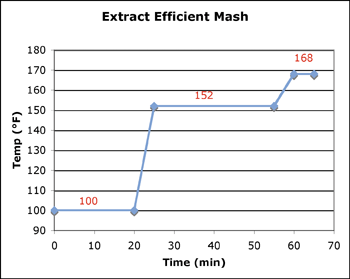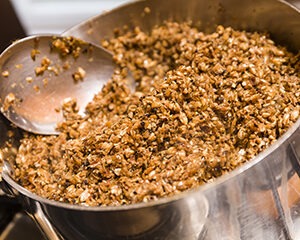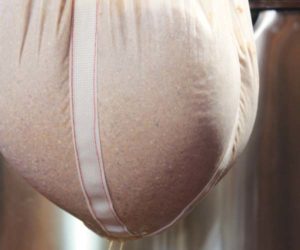The Science of Step Mashing
Step mashing is a mash program in which the mash temperature is progressively increased through a series of rests. The ubiquity of well-modified malts has virtually eliminated the need to perform a step-mash in most situations. So why should you learn more about the process and science behind step-mashing? Simple, you can produce more variety and sometimes better, more distinctive beers when following a step mash program.
Step-mashing allows brewers to manipulate the mash to get the desired wort, dry or sweet, velvety or lightly astringent. You may also find that your extract efficiency goes up slightly-to-moderately when using a step-mashing regimen. Understanding the science behind step mashing can help all-grain brewers — and even partial mash brewers — decide on an appropriate mash regimen for their beers.
Malt Modification
Malting plays a fundamental role in the brewing process. The goals of mashing are essentially an extension of the goals of malting, and what happens in the malthouse should influence your choice of a mash protocol.
The main purpose of malting is to begin germination of the barley, then toast the grain to stop the seed from sprouting. Brewers care about this because it will start two vital degradations and also produce the fundamental enzymes of mashing. During the malting process, gums (glucans) in the cell walls of the barley are broken down. Likewise, proteins are broken down. This breakdown supplies the wort with amino acids necessary for yeast health and lowers the possibility of haze or biological instability in the finished beer. Finally, malting causes the barley to produce the starch-degrading enzymes that will be employed in the mash. The degree to which gum and protein degradation has progressed is called modification. These days, most malts are fully modified. The glucans and proteins are degraded to a point that brewers only need to convert the starches in the grain to make good quality wort. Undermodified malts are those in which modification has stopped short, essentially leaving the brewer to complete those tasks in the brewhouse.
If a malt is undermodified, it will clearly say so in the name. For example, Briess makes a malt called Less Modified Pilsner Malt. Conversely, if a malt name does not mention its level of modification, it’s fully modified. Seed barley is very hard. Malt modification proceeds from one end of the barley grain to the other, softening it. Another way to identify an undermodified malt is to chew it — if it has a hard, “steely” end, then it’s undermodified. See Table 1 for a summary of various malt types and their levels of modification.

If you have purchased an undermodified malt — or have made your own malt at home, which usually yields unevenly modified kernels — a step mash (or decoction mash) may be your best option.
Enzymes
Enzymes are proteins that catalyze chemical reactions, allowing them to occur at a much faster rate than they would on their own. (There are also enzymes made of RNA molecules, but these don’t play a direct role in mashing.)
A protein is a long, unbranched chain of amino acids, ranging from as short as about 50 amino acids long for insulin to up to over 8,000 amino acids in some of the largest proteins. In some regions of a protein, an amino acid sequence will form a “coil” (called a helix). In others, the string might double-back on itself and form what’s called a sheet. The whole sequence, with its local regions of helices and sheets, folds into a 3-dimensional shape. The most common bonds that stabilize the enzyme’s shape are know as Van der Waals forces, weak attractions that can easily be broken by increased temperature or changes in pH.
The shape of an enzyme determines its function. This is because the substrate for a given enzyme will fit into the enzyme’s “active site.” A simple analogy for enzyme action can be drawn using the video game Pac-man. If the Pac-man character was an enzyme, his mouth would be the active site, which would grip the substrate (or substrates) and catalyze a chemical reaction. For example, when an amylase enzyme breaks down a starch molecule, its active site “grips” the starch and breaks the bond between two sugar residues in the starch strand.
Unfortunately, analogies to 1980’s-era video games sometimes have to be abandoned when the finer points of enzyme action are discussed. Contrary to what the Pacman analogy might imply, enzymes do not physically “chew” on molecules.
The protein-degrading and starch-degrading enzymes in a step mash work by a process called hydrolysis, which loosely translates as “breaking with water.” For example, amylase enzyme will bind to two adjacent sugar molecules on a starch strand. When a water molecule bumps into the enzyme and substrate complex, the enzyme catalyzes a reaction between a hydrogen ion (H+) from the water molecule and one of the sugar molecules, and a second reaction between a hydroxyl ion (OH-) and the other sugar. Essentially, the bond between the two sugars is replaced with a water molecule, which splits into two parts, breaking the starch strand. Once the bond is broken, the change in the shape of the molecules in the active site causes the enzyme to release, where it is free to float around in solution until it bumps into another starch strand.
Now, if any of the bonds that stabilize an enzyme’s shape are disrupted, then the enzyme will no longer function because the active site’s shape changes and the substrate won’t fit in it. When an enzyme’s structure is disrupted by heat, we say that the enzyme is denatured. Once denatured, most enzymes — including the enzymes relevant to mashing — will not fold back into their active shape. Therefore, generally speaking, denaturing permanently deactivates an enzyme.
In the brewing literature, the optimal temperature ranges for various enzymes are given. (For a summary, see Table 2.) For advanced brewers, it is important to understand what these mean. Enzymes are simple “machines” that work solely due to their shape. In solution, if they happen to bump into their substrate(s), they catalyze a chemical reaction. As an enzyme solution is heated, the rate of reaction increases as the time it takes for enzymes to randomly bump into substrate molecules is decreased because the individual molecules are moving faster through the solution. Enzymes are active at all temperatures between the freezing point of a solution and the temperature at which the enzyme denatures. When the temperature range for a given enzyme is stated in the brewing literature, it is the range of temperatures that result in good brewhouse performance for that enzyme. It does not mean that enzyme is inactive outside of that range. All brewing enzymes are active below their stated range. However, at lower temperatures, they are working more slowly. The top end of an enzyme’s range is determined by the enzyme’s activity and denaturation point. Heating a step mash over the top end of an enzyme’s range does not cause that enzyme to stop working instantly. It takes time for enzymes to denature. In some cases, enzymes will actually denature within their stated range. For example, at 149 °F (65 °C), beta-amylase is denatured within 40–60 minutes and alpha-amylase activity will cease after 2 hours at 153 °F (67 °C). The point is that, by changing mash temperatures, you are not cleanly switching enzymes on and off. Due to their simple mechanism of action, your control over them is much more “squishy.”
Still, there are four factors that determine the speed of an enzyme-catalyzed reaction — the enzyme’s concentration, the substrate concentration, the temperature of the mixture and its pH — and all four of these can be manipulated in a step mash to alter your wort’s qualities.
The Acid Rest
The acid rest is the first rest you might schedule after dough-in in any full step mash or decoction mashing regimen. The acid rest has two functions; to lower the pH of the mash to an appropriate range and to break down the dreaded glucans that can gum up a mash. The typical range for an acid rest is between 95–113 °F (35–45 °C). At this temperature, the enzyme phytase breaks down a molecule called phytin and releases phytic acid, which lowers mash pH.
Phytase is very susceptible to heat and most of these enzymes will be destroyed during extended malting. So phytase will only be present in very lightly-kilned malts. Therefore it will only really benefit a mash made up of undermodified malts in soft water with little buffering capability — a rather small niche. Usually, this situation is addressed by simply adding acid to the strike water. Another reason that acid rests are not widely used is that it takes at least an hour to bring about any meaningful change in mash pH.
The second and more important purpose of a rest in this temperature range is to take care of the majority of glucans, also known as gums. Beta-glucans are a form of carbohydrates that are found in the protein layer surrounding the starch molecules in grains and beta-glucanase is an enzyme that will degrade these molecules. Various glucanases are active all the way up to about 140 °F (60 °C), but the most important glucanase, 1,4 beta-glucanase has an optimal temperature right around 113 °F (45 °C). Beta-glucans are found in highest concentrations in rye, wheat, oats and undermodified malts. Beta-glucans are also known to lead to haze in beer if not properly degraded.
In a fully-modified malt, the level of beta-glucans should not be a problem, but if you experience lautering problems or haze with your favorite malt, try a 15-minute rest in the acid rest temperature range.
The Protein Rest
A rest in the temperature range between 113–138 °F (44–59 °C) has traditionally been called a protein rest. These days, many brewing scientists do not think that much protein degradation occurs during mashing and this is part of the reason that it is left to the maltster. However, it’s worth reviewing the possible enzyme actions that may occur in this range.
There are two specific types of enzymes that were thought to be active in this range — proteinase and peptidase enzymes, collectively known as the proteolytic enzymes.
Proteinase is an enzyme that works on longer-chained proteins turning them into medium length chains. Peptidase enzymes chop up the moderate to short chains and break them down to their component form. Conveniently, these two enzyme groups have slightly different optimal temperature ranges, so you can hypothetically favor one or the other.
Brewers do not want a lot of longer chain proteins in their wort. A high level of big proteins can lead to haze and instability. However, brewers do want medium length protein chains because they are beneficial for a beer’s body and for foam retention. The optimal range for peptidase is between 113–128 °F (45–53 °C) while the optimal range for proteinase is 131–137 °F (55–58 °C). A 15–30 minute hold in the proteinase range was thought to diminish haze, but not negatively impact foam or body.
One important point to note is that the low temperature rests have been found to be more effective with thick mashes. Therefore you may want to mash-in when utilizing these low temperature rests between 0.8–1.0 qts./lb. (1.7–2.1 L/kg). You can then thin the mash with boiling water when raising the temperature to the saccharification rest(s).
Some beta-glucanase activity also occurs in the protein rest range and some brewers perform a “protein rest” for this reason. Unless you have a very good reason — for example, if you know you have a high-protein malt on your hands — avoiding a rest in the 113–128 °F (45–53 °C) range is probably prudent as you will potentially avoid any problems with head retention. When brewing with undermodified malt, you should rest in the 131–137 °F (55–58 °C) range — at a minimum, it will break down some gums.
Whether or not meaningful amounts of protein degradation are occurring in this range, a rest here does affect the quality of your wort. For example, the time and stirring that goes on in a step mash may promote better extraction efficiencies — especially for homebrewers not used to stirring their mashes or those who typically get marginal extraction rates.
Starch Conversion
The only required rest in any mash program is a rest in the starch conversion, or saccharification, range. When mashing fully-modified malts, a single rest in this range is a very popular option.
Starch conversion is performed by two separate enzymes, which attack starch chains in different manners. The two enzymes are collectively referred to as the diastatic enzymes. The typical starch conversion rest occurs between 142–162 °F (61–71 °C). (Sometimes you will see a smaller subset of this range stated, for example 150–158 °F (66–70 °C). Remember that enzyme action is not an all-or-nothing thing and allow for the fact that any boundary to any temperature range in brewing is somewhat arbitrary.)
Beta-amylase attacks the ends of starch molecules and “snips” off the final two sugar residues, producing maltose. One noteworthy aspect to this is that starch molecules can be very long. If you want beta-amylase as your primary starch converter, then your mash will need a long rest in its optimal range. A 1–2 hour rest in the 140–145 °F (60–63 °C) range is, in fact, one way for brewers produce a highly-fermentable wort for drier beers.
Alpha-amylase is the second enzyme that is used for starch conversion. The optimal temperature range of alpha-amylase is around 155–162 °F (68–72 °C), although it is still active to a lesser degree at lower temperatures. Alpha-amylase attacks starch molecules at random points along their chains. It is bulky enough that it is not able to attack the starch molecules around branching points. A rest in the high end of the alpha range will result in a less fermentable wort, resulting in a sweeter, more full-bodied beer. In particular, a short (20 minute) rest at 158–162 °F (70–72 °C), in a relatively thick mash (around 1.0 qt./lb. or ~2 L/kg) will produce a very thick, full-bodied beer.
This is particularly true for beers brewed with low-enzyme malts, such as British pale ale malts.
Alpha-amylase is usually used in conjunction with beta-amylase to produce moderate to full-bodied beers. The basic idea is that the “random” action of alpha amylase opens up new ends for beta–amylase to work on. Working together in the 150–152 °F (66–67 °C) range, these enzymes will produce a moderately fermentable wort and this is a popular range for single-infusion mashes among homebrewers. Increasing this temperature up to 154 °F (68 °C) will result in a more full-bodied beer, but not so “thick” as to be overly sweet or cloying.
Typical resting time is 60 minutes, but with many malts, conversion occurs much more quickly than this. For a moderate to full-bodied beer, you can begin running off the wort as soon as an iodine test shows a negative result (no color change, indicating that the test is not detecting appreciable amounts of starch.)
Alpha-amylase is less active and less stable in worts with low levels of calcium ions. This instability is increased in thin mashes and mashes in which the pH is above the recommended range.
For any beer that is supposed to be full-bodied, a mash out — a 5-minute rest at 168–170 °F (76–77 °C) — is recommended. Also, ensure that your grain bed temperature stays at this temperature during sparging by heating your sparge water to the appropriate temperature — which is dependent on the heat loss of your system during lautering. This will ensure that amylase enzyme activity is decreased, due to denaturation of the enzymes. As such, your wort fermentability will not increase appreciably during wort collection due to continued enzymatic action.
Performing a mash-out also decreases wort viscosity and makes lautering easier.
Step Up to the Plate
The following figures show some suggested step mash programs for various types of beer. Most homebrew texts also list various combinations of steps. (For the most common decoction mash programs, see the “Techniques” column in the December 2006 issue of BYO.)
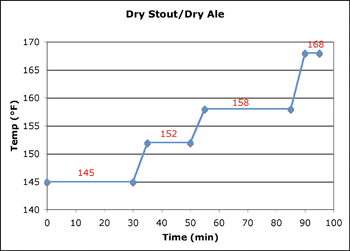
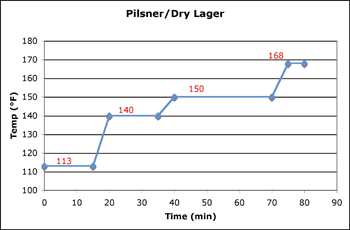

When deciding on a mash program, you need to consider your malt type, your beer style and its desired characteristics and sometimes even your brewing setup. Keep in mind that a more complicated mash program does not necessarily result in better beer. Conversely, if you have been experiencing poor lautering, haze, low extract efficiency or worts that are not as fermentable as you would like, adding the appropriate rest to your mash may solve the problem. When using undermodified or homemade malt, you will need to do a step mash — at a minimum, you should hold in the protein rest range before boosting the temperature to the starch conversion range. The more undermodified or variably modified your malt is, the more an involved step mash will improve yield and wort quality.


